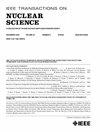Assessing the Reliability of FPGA-Based Quantized Neural Networks Under Neutron Irradiation
IF 1.9
3区 工程技术
Q3 ENGINEERING, ELECTRICAL & ELECTRONIC
引用次数: 0
Abstract
SRAM field-programmable gate arrays (FPGAs) are popular computing platforms for implementing neural networks (NNs) due to their flexibility and low recurring engineering costs. Nevertheless, reliability concerns arise due to their susceptibility to radiation effects, especially considering high-altitude or -scalability applications. In this work, we explore the resilience of quantized, and especially binarized (e.g., use binary values to represent the weights) and nearly binarized, FPGA NNs to neutron-induced errors. Specifically, we study the impact of various NN design parameters, such as the degree of quantization and parallelization, the type of memory for storing the weights, and the diversity of the input images on the NN reliability. To achieve this, we exposed to accelerated atmospheric-like neutron radiation a large set of NN designs built through FINN, a state-of-the-art development framework targeting FPGA NN accelerators, using different quantization, folding, and weight storage schemes. We examine how these parameters affect the tradeoff between area, performance, and reliability, calculating various metrics such as the dynamic cross section (DCS), failures in time (FIT), and mean executions between failures (MEBF). Our findings show that less quantization (i.e., larger bit precision), as well as less folding (i.e., more parallelization), leads to improved reliability (i.e., lower FIT and higher MEBF). In contrast, these two factors push the performance and area of the NNs in opposite directions (i.e., less quantization and folding result in lower latency but more FPGA resources). Moreover, the results reveal that the choice of the memory type (i.e., block RAM (BRAM) or distributed RAM) for storing the NN weights impacts the reliability metrics, with the mixed memory configuration providing the highest reliability.中子辐照下基于fpga的量化神经网络可靠性评估
SRAM现场可编程门阵列(fpga)由于其灵活性和低重复工程成本而成为实现神经网络(nn)的流行计算平台。然而,由于它们易受辐射影响,特别是考虑到高海拔或可扩展性应用,可靠性问题也随之出现。在这项工作中,我们探讨了量化,特别是二值化(例如,使用二值值表示权重)和近二值化的FPGA神经网络对中子诱导误差的弹性。具体而言,我们研究了各种神经网络设计参数,如量化和并行化程度,存储权重的存储器类型以及输入图像的多样性对神经网络可靠性的影响。为了实现这一目标,我们使用不同的量化、折叠和重量存储方案,通过FINN(一种针对FPGA神经网络加速器的最先进开发框架)构建了一套大型神经网络设计,并将其暴露在加速的大气样中子辐射中。我们将研究这些参数如何影响面积、性能和可靠性之间的权衡,并计算各种度量,如动态横截面(DCS)、及时故障(FIT)和故障间平均执行(MEBF)。我们的研究结果表明,更少的量化(即,更大的位精度),以及更少的折叠(即,更多的并行化),导致提高可靠性(即,更低的FIT和更高的MEBF)。相比之下,这两个因素将神经网络的性能和面积推向相反的方向(即,较少的量化和折叠导致更低的延迟,但更多的FPGA资源)。此外,结果表明,存储神经网络权重的存储器类型(即块RAM (BRAM)或分布式RAM)的选择影响可靠性指标,混合存储器配置提供最高的可靠性。
本文章由计算机程序翻译,如有差异,请以英文原文为准。
求助全文
约1分钟内获得全文
求助全文
来源期刊

IEEE Transactions on Nuclear Science
工程技术-工程:电子与电气
CiteScore
3.70
自引率
27.80%
发文量
314
审稿时长
6.2 months
期刊介绍:
The IEEE Transactions on Nuclear Science is a publication of the IEEE Nuclear and Plasma Sciences Society. It is viewed as the primary source of technical information in many of the areas it covers. As judged by JCR impact factor, TNS consistently ranks in the top five journals in the category of Nuclear Science & Technology. It has one of the higher immediacy indices, indicating that the information it publishes is viewed as timely, and has a relatively long citation half-life, indicating that the published information also is viewed as valuable for a number of years.
The IEEE Transactions on Nuclear Science is published bimonthly. Its scope includes all aspects of the theory and application of nuclear science and engineering. It focuses on instrumentation for the detection and measurement of ionizing radiation; particle accelerators and their controls; nuclear medicine and its application; effects of radiation on materials, components, and systems; reactor instrumentation and controls; and measurement of radiation in space.
 求助内容:
求助内容: 应助结果提醒方式:
应助结果提醒方式:


